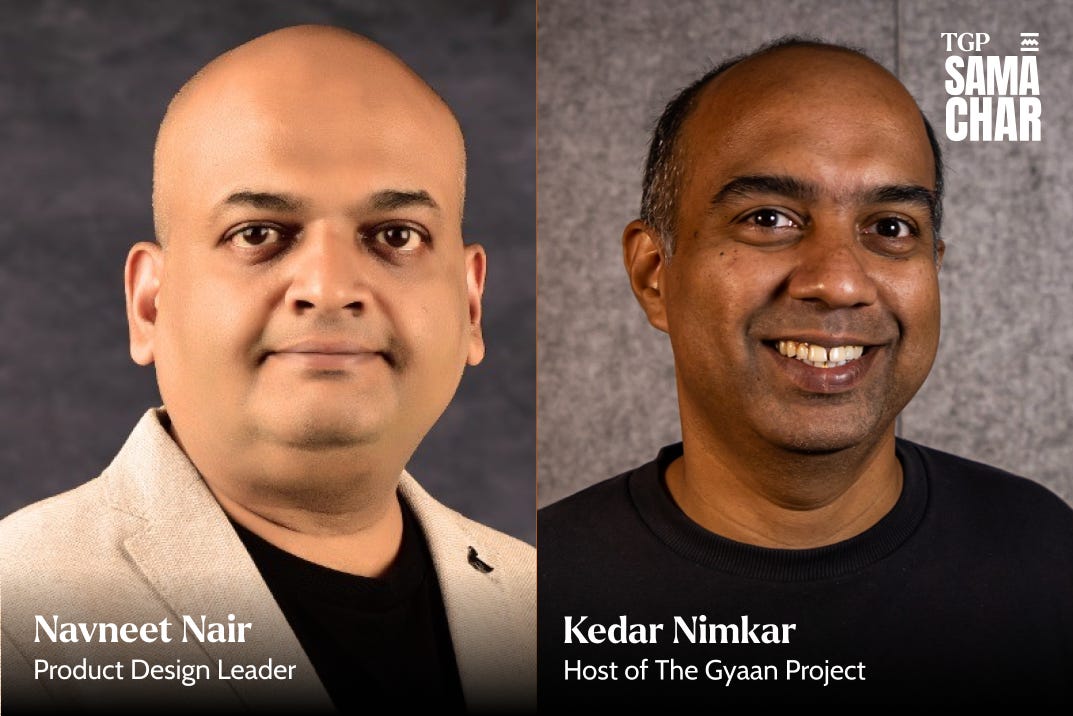Startups & digital design: 4 Lessons from Navneet Nair
What is the relation between football and team building in startup? Can Startups compete with established players? What is the danger of chasing profit or user engagement blindly?
On June 29th, we have National Statistics Day honoring Professor Prasanta Chandra Mahalanobis’s pioneering contributions to data-driven economic planning. For some uncanny reason, I felt like re-looking at my conversation with Navneet Nair ( ▶️ Ep.202 ), where we spoke about data driven insights for startups. It also reminded me of PhonePe Pulse which shows real time data of transactions happening in India. I guess, that was good enough to bring you this week’s Samachar with Navneet sharing 4 lessons for startup founders and designers.
Navneet Nair is a product design leader with over two decades of experience at Google, Yahoo, and as former Head of Design at PhonePe (which is what he was while recording the podcast). He is a big advocate of value-centered design and now serves as Director of UX at Target.
1️⃣ How should startup founders think about team building?
Short Answer: Think like football and not basketball.
Long Answer: Startups are like football. Success depends on all players. One weak link can cost the goal. Studies have shown that improving your weakest player by 5% gives a 30% lift in efficiency. On the contrary improving your best player by 5% gives only 3% lift. Basketball, by contrast, allows a single great player to carry the team, like Michael Jordan. In startups, founders should identify and improve the weakest function—be it design, tech, or marketing—to build a balanced, high-performing team.
Which is the “weakest link” in your startup right now—and what’s stopping you from fixing it?👇 Drop your comments.
2️⃣ How can startups compete with established players?
Short Answer: Find the gap.
Long Answer: India had only 2.5 lakh ATMs for 1.3 billion people (0.0002 ATM per person). Most are in urban areas. I was in a village in Karnataka, where the ATM was inside the bank building. On Sunday, the bank was closed so I couldn't use the ATM. Most people use to stand in bank lines to withdraw money. This is the gap that we found and asked ourselves what if our PhonePe merchants become an ATM? You scan a QR code, get money from the merchant. Within a short period, we had 10 lakh merchants signed up for this. We became India's largest ATM network.
There are some cool stats around PhonePe UPI transactions - Link
3️⃣ What's the danger of focusing only on profits?
Short Answer: Boeing syndrome.
Long Answer: Boeing 737 Max had wrong center of gravity. They introduced software to adjust the tilt but didn't tell pilots. When planes started adjusting lift opposite to what pilots were doing, it caused crashes.
Ford Pinto was built under $2000 in 25 months to compete with Japanese cars. Even Steve Jobs drove this car because it looked good. But in rear-end collisions, the car caught fire. About 200 people lost their lives over 5-10 years. These cases show what happens when you only keep profit in mind without considering broader impact.
K.K. Create in her recent short asked some difficult questions regarding the role of Boeing in recent AI171 air crash in Ahmedabad.
4️⃣ What happens when startups chase user engagement blindly?
Short Answer: Digital addiction trap.
Long Answer : When I was designing for social media, I made sites so easy to use that people became addicted. I didn't think about addiction then. I just wanted users to return. Now we have “The Social Dilemma” on Netflix talking about these problems. User-centered design can make products so engaging that they become harmful. That's why apart from profit and costumers, startups must look at value proposition from an early stage. You need to ask why you're building this product in the first place.
Jonathan Haidt in his book “The Anxious Generation” delves into this question from an academic perspective.
Throughout the conversation Navneet stressed on the importance of behavioural economics, data driven decisions and value centered design. I would strongly recommend listening to the entire episode (Youtube | Spotify | Substack | ApplePodcast) for more amazing takeaways. Let me know what do you think about this in the comments.





While listening to Navneet's podcast I felt like i'm listening to some Design spiritual guru, the wisdom and with ease at which he talks.